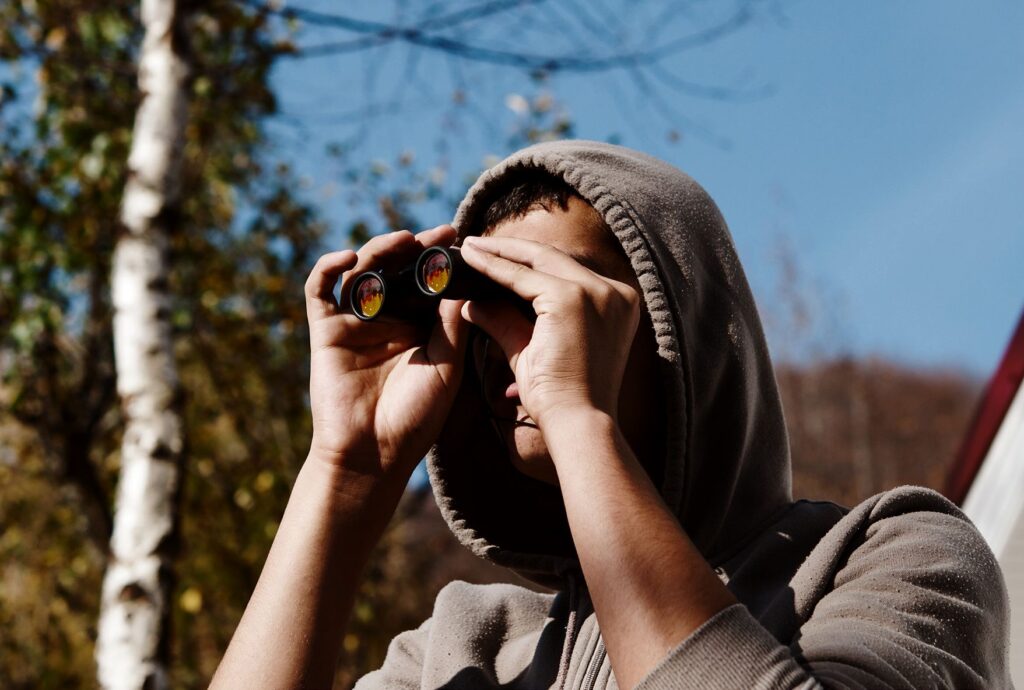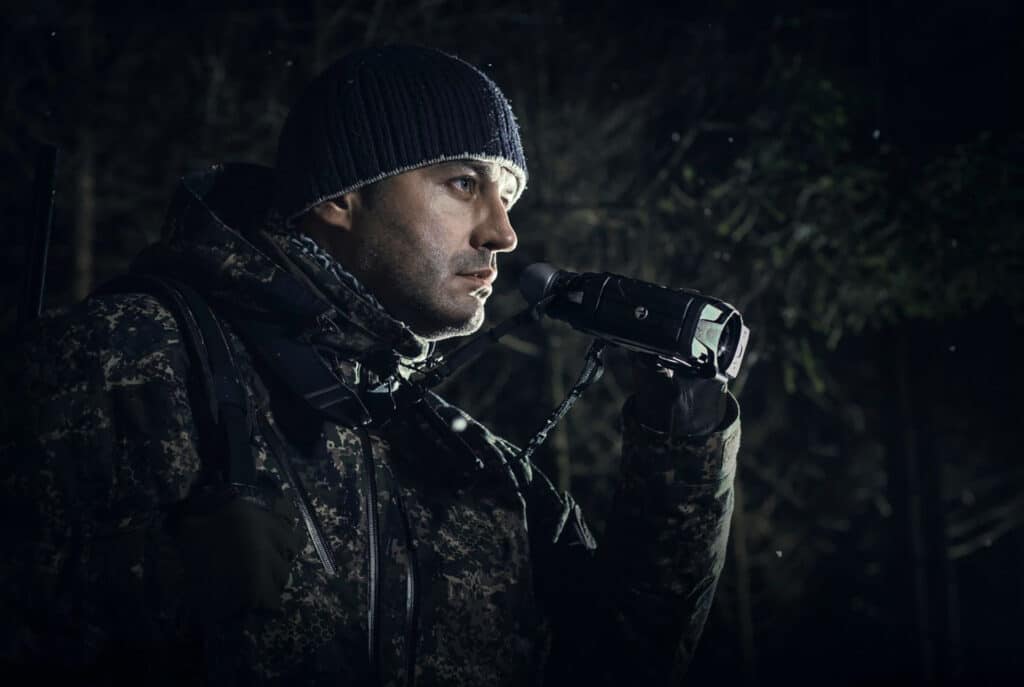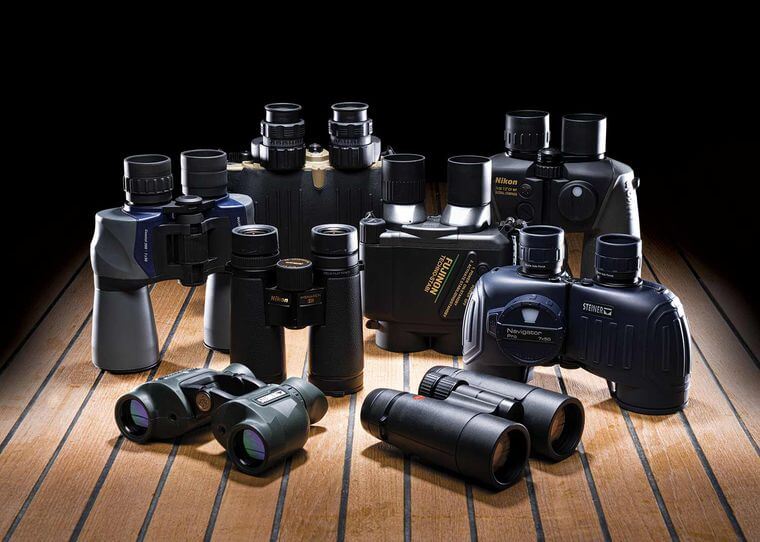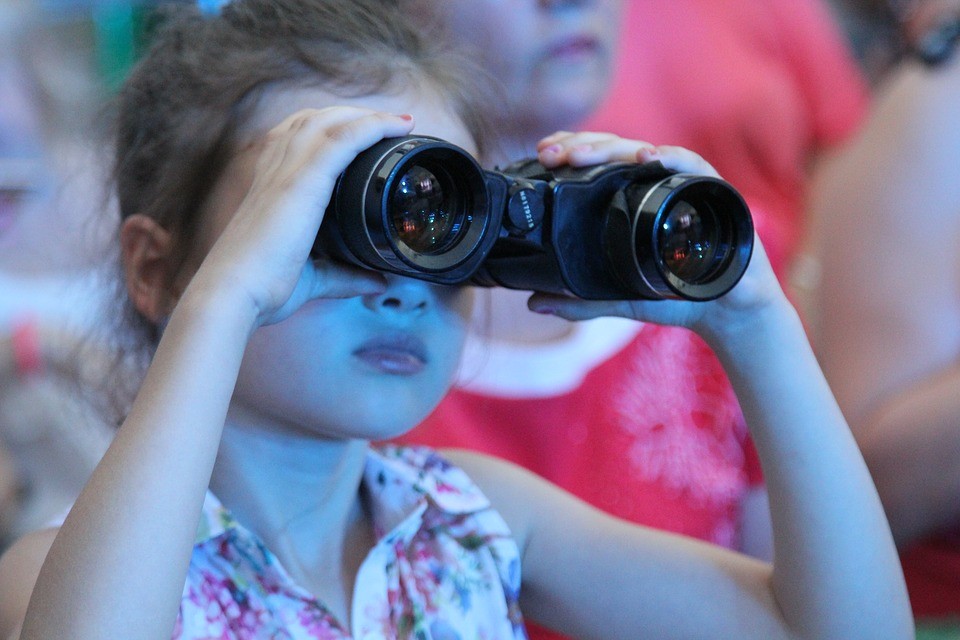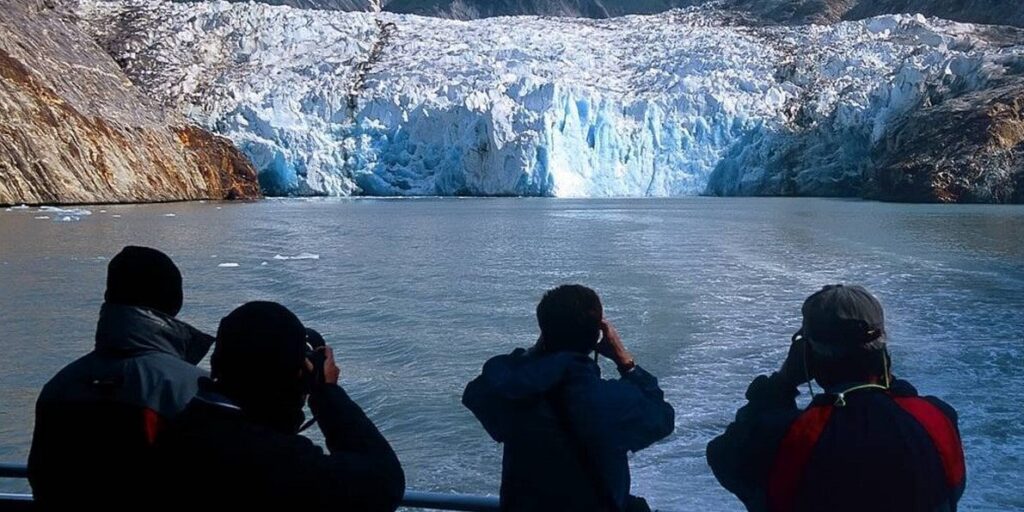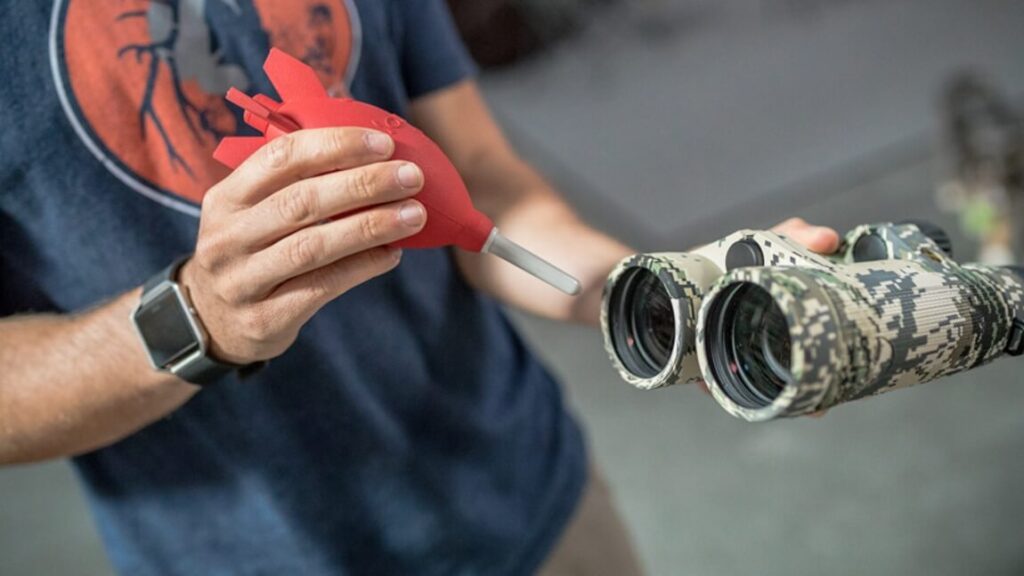

If you are going on Safari then it could be the trip of a lifetime, it is vital to ensure that you have the right equipment to thoroughly enjoy it and ensure that you see the wildlife in all of its glory, the best binoculars for safari are the best way to do this, as you can see everything that the landscape will have to offer. The wrong binoculars will leave you disappointed, and it is easy to buy dud products that don’t help your eyes.
In our guide we’ve looked at weather resistance, prisms, which need to be high-quality and reduce the number of lenses that are required. We’ve also looked at the field of view, so how much you can see, the lens coating and protection, and of course the eye relief, which relates to the distance between eye and eyepiece within the binoculars.
Other features: waterproof, fogproof, twist eyecups, carrying case, polycarbonate body
The Celestron Nature DX 8×32 is our editor’s choice. It has a high-quality coaxed lens, and features a roof prism system, the BAK4. The binoculars are relatively compact at 5” in size and weigh just 18 oz so they are pretty good for taking out and about with you.
The body is waterproof so that it won’t ruin your view even in rainy conditions. Everything you need also comes with the set of binoculars, so you get lens caps, an eyepiece rainguard, a neck strap, a lens cloth, and the manual to show you how to use it. The field of view is nearly 400 feet even at a distance of 1000 yards. Eye relief with these binoculars comes in at 17.5mm, which is pretty standard for high-end binoculars.
What we like: These are really flexible, with twistable eyecups and a lightweight and portable design. This is exactly what you will be looking for when you go on safari, and they are good for hanging around your neck or taking out and about with you.
What could be better: A replacement neck strap or a better case for these binoculars would be a bit of an upgrade, they are okay but not quite up to scratch for the best binoculars for African safari.
Other features: waterproof, fogproof, twist eyecups, carrying case, lifetime warranty, magnesium chassis
Bushnell is a very good brand with a rich history when it comes to the manufacture of optics, including binoculars. These are some of the best small binoculars for safari and have impressive features. It was hard to separate them from the editor’s choice model.
They have a similar field of view, with 340 ft at 1,000 yards. The lens coating is impressive, with the RainGuard HD lens being repellent to water meaning a clear view even when weather conditions don’t really suit. The eye relief is 18mm.
Like a lot of the other options the eyecups twist so that it is easy to adjust them to your preference and eye shape.
In terms of the build-quality, they have a brilliant magnesium chassis, and are able to offer a lifetime warranty. In spite of this sturdy chassis the binoculars only weigh 23.5 oz, which is fairly light for the best safari binoculars.
What we like: The fantastic build-quality is backed up by a lifetime warranty meaning that your purchase is totally protected and you don’t have to worry about breakages. The lenses are also brilliant in trying conditions as far as the weather is concerned.
What could be better: The focus adjuster feels a little bit flimsy and could be prone to breakage, which isn’t really what you would expect from an otherwise sturdy pair of binoculars for African safari.
Other features: waterproof, fogproof, O-ring sealed, nitrogen field, rugged design
Nikon is another huge brand when it comes to optics and not only do they produce some of the world’s greatest cameras, they have amazing binoculars such as these, the Nikon Trailblazer 10×25 ATB.
These are some of the best lightweight binoculars for safari. You can take advantage of their light design as they are less than 16 oz in total.
The eye relief is 10mm, which is not as high as some other models on the list so not as flexible for your eyes. The coating is “multi-coated” meaning the lenses have been treated for a good waterproof design and they are also fogproof.
They are nitrogen filled, and the design is intended to “maximize light transmission for brighter views and improved color fidelity and contrast”.
What we like: It is very hard not to comment on what you get for your money with these Nikon binoculars, they are among the best compact binoculars for safari but they are incredibly good value, and to find such good binoculars under the $100 mark is very unusual. The relatively rugged build-quality is worth noting, too.
What could be better: The eye relief is 10mm, which is far less than some of the other models on the list, so you need to think about whether this is a priority for you or not before you make your purchase.
Other features: waterproof, fogproof, dustproof, lifetime warranty, easy grip
The Zeiss brand is famous for the manufacture of lenses and this is no exception. The Zeiss Terra ED 10×42 is more expensive than some of the other options, but the lens is dustproof which means that over time it won’t become interrupted or ruined by specs of dust, which in the 10x magnification would be a lot more annoying than you can imagine.
The field of view is large and the images are pretty steady, with a lens diameter of 42mm.
10x magnification for delivering breathtaking enlarged images; field of view at 1000m – 110 m; apparent field of view – 60°; the TERRA ED 10×42 binocular offers you both large fields of view and steady images. These binoculars are waterproof and weatherproof so they can cope with extreme temperatures among other challenging weathers. They’re multicoated and give clear imagery even at a 1000 yard distance, where they have a field of view over 300ft.
What we like: Robust, clear, and they have a brilliant contrast with reliable dustproof imaging at 10x magnification.
What could be better: It is debatable whether you can get a similar level of quality at a lower price, these are not the most affordable binoculars on the list so if you are looking for the best budget binoculars for safari you may need to look elsewhere.
Other features: waterproof, innovative carrying system, adventure harness system
We’re definitely getting into the more expensive binoculars for safari here, with the Leica Camera Co. 8×42 Trinovid HD Binoculars, which have a huge field of view and plenty of other features to love, but we’ve named them the best when it comes to their harness system, which is brilliant for quickly and easily whipping out your binoculars to ensure you don’t miss any of the beautiful wildlife.
The harness system is the number one vital feature, it straps around your body and allows you to instantly grab them and spot the incredible animals.
The field of view is 414 feet which is one of the biggest you will find. Like a lot of the pricey models it is waterproof, which means that it can cope with what the weather throws at you when in challenging climates.
The HDC coating/Leica AquaDura reflects the high-quality of the product. Leica has worked hard creating top-end optics and that is what is available with these.
What we like: The best thing about these is definitely the harness that can be wrapped around you while you are on safari.
What could be better: Not everyone wants to spend close to $1000 on binoculars and these are quite an expensive model when compared to a lot of the other binoculars on this list. Also, though the harness is great, it is big and bulky and can make it harder to carry.
Other features: waterproof, HDX special glass with maximized light transmission, abrasion-resistant lens coating, open bridge
The ZULU7 are something very different when compared to a lot of the other models, and we have named them the best bridge. You can use this model with one hand and enjoy quick, easy and portable use.
They feature a roof prism and have eye relief at 17 mm which is pretty standard. The field of view is much more narrow, but this is to be expected with this style of binoculars.
The HDX glass means maximized light transmission, and it also helps these binoculars becoming some of the best small binoculars for use in low light.
The open bridge makes it easy to adjust and use one-handed, freeing up your other hand for a camera or to hold on to a moving vehicle, for instance. As you would probably expect from a quality pair of binoculars, they are multi-coated with a high quality lens and even have a waterproof design. They aren’t just able to cope with a few drops of rain, you can submerse these up to 16 ft and they will still work very well.
What we like: They are very small, compact and the easiest option to use with one hand.
What could be better: The field of view is very narrow, so you don’t quite get the best view of the surroundings from a long distance.
Other features: waterproof, lifetime warranty, wide angled, diopter lock
The Kowa Genesis Series XD 10x33mm Binoculars GN33-10 are a great option for those who don’t mind spending a little more on their binoculars. They have a wide angle, and a military-style design. The product is incredibly hardy and durable so it shouldn’t break any time soon.
Your field of view at 1000 yards is 357 ft which is certainly respectable enough. They’re also a lightweight model.
The contrast and color reproduction are two more of the best things about these binoculars, and the detail you see using them is absolutely fantastic. The lens is multi-coated and gives great protection against the weather and also against dust so over the years your binoculars should retain their quality just like the day you bought them.
What we like: One of the fantastic things about these is the diopter lock that lets you take full control of the refraction and adjust the binoculars perfectly so that you can see exactly what is going on ahead of you.
What could be better: Once again, it is worth considering the price of this model, as it is over $1,000. It does have a lifetime warranty, but this is still a big investment for most going on a safari. It all depends on what you are hoping to spend.
Other features: waterproof, fogproof, tripod adaptable, open hinge design
Some people looking for binoculars for safari are looking for a versatile model that can easily be used for other things. The Celestron Granite 7×33 Binoculars 71378 might just be that model of binoculars as it has features that are great for so many different uses, you could take this birding just as easily as on safari.
It has the weatherproof functionality that most of us are hoping for when we buy binoculars, and can cope with rain or with fog.
The field of view is very wide at nearly 500 ft at a distance of 1000 yards. The ED glass (extra low dispersion) means that the resolution and contrast are true to real life and that your view is spectacular when on safari.
These binoculars can even be set up for use with a tripod if you wish, so you can set yourself up in a good spot on safari.
This comes with plenty of accessories, Carrying Case, strap, manual, lens cloth, caps and even a neck strap are all included.
What we like: These versatile binoculars can be used for pretty much anything you wish. Take them on safari or go birding with them. They also don’t cost a huge amount of money for such reliable binoculars, and are comparable to some models that are twice the price.
What could be better: Some of the controls and dials feel a bit flimsy and plasticky.
Are you buying binoculars for the first time? Perhaps you have booked a once-in-a-lifetime trip and you want to make sure you soak everything up while you are on your vacation. Binoculars can seem pretty intimidating at first as you might not fully understand all of the features and functions. How do you establish what is best?
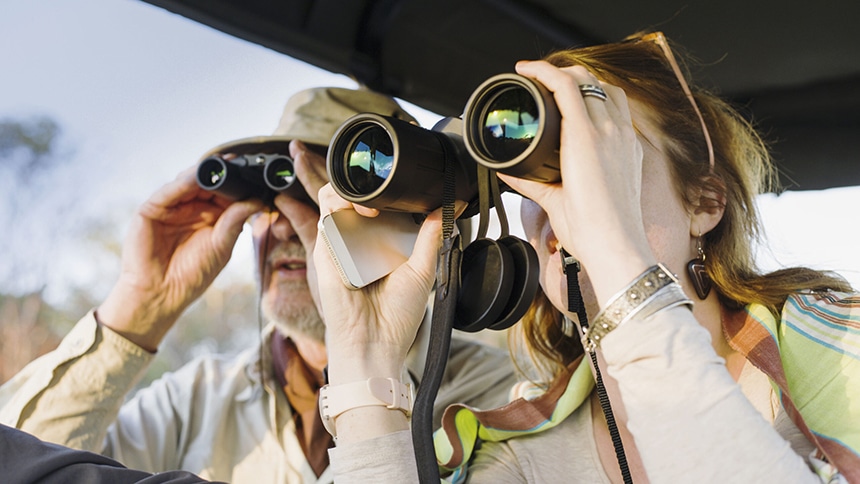
The top considerations are all listed below as the top features to consider when choosing your binoculars. These are also the features we’ve looked at when creating our reviews, and the criteria we’ve used to compare one pair of binoculars to another.
Magnification is one of the more self-explanatory functions of binoculars. It is simply measured in x – the number of times the size the magnification will make something appear.
However, the objective lens diameter plays a big part here. If you are looking at a large diameter lens it will probably be a pretty big and bulky set of binoculars, but they let in a lot more light. This means that you can get a brighter image, so if you are going on a night safari, for example, you want to make sure you are collecting plenty of light so that you can see what is happening.
Weather resistance for binoculars comes in a few different forms. If you are in Africa, you can get rainstorms, just like anywhere else in the world. They might not be common but when they do come they can really teem down. This means that you need to be prepared with weather resistant binoculars. As well as being able to cope with the water, they should also be able to cope with the extreme heat conditions. In some scenarios, it can get very, very hot, and this can cause issues with optics. Be very cautious if you are buying cheaper models as they might not cope very well in the hot conditions.
If you have ever seen live sport on television and you see footage that has been zoomed in to a high degree of magnification, it will start to look shaky in some situations. If you don’t have very good image stability with your binoculars then this could equally be a problem with your safari binoculars.
It is pointless having binoculars that can magnify and let you see an amazing creature hundreds or even thousands of yards away, if it is going to look shaky anyway so you can’t see what is happening unless you have an incredibly steady hand. If you are in a vehicle image stability becomes even more vital.
This is not the most technical of features to think about. The size and weight of binoculars for safari is a pretty self-explanatory set of features. If you are going on safari and you need to pack a bag including an overnight bag, you will want to think more about the size and weight. For instance, the Leica 8×42 Trinovid HD is a fantastic option but the harness makes it very big and bulky to carry around. It’s easier due to the fact you can strap it to you, but you do need to consider the extra size.
Many of the models on our list weigh a similar amount. Around the 25 Oz mark is pretty good for binoculars for safari.
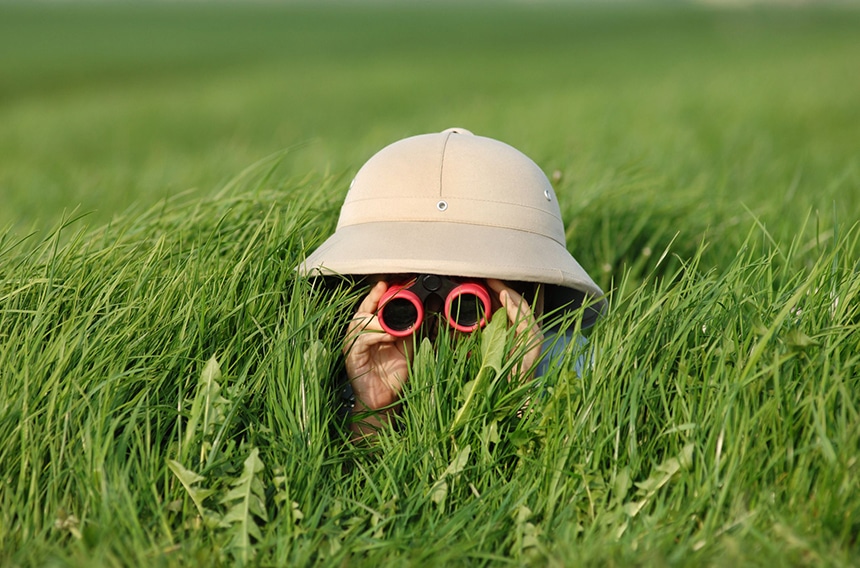
The prism system is absolutely vital to binoculars and helps to make them work. Porro and Roof are the two main types of prism that you get in binoculars for safari. The prism binoculars have objective tubes, these are slightly offset from the eyepieces. These prisms then angle from the eyepieces toward the lenses. In terms of a roof prism model, there are two straight tubes which means they are much smaller and more portable.
Other types include the Schmidt-Pechan system, which is a way to flip an image 180 degrees when magnifying. The relatively expensive Zeiss Terra ED 10×42 is one of the options to use this system.
The optical coating of a binocular can be one of its main selling points, they are all slightly different depending upon which model you buy, and some can do better jobs than others. Some offer protection, but this isn’t the only role of the binocular coating.
The coatings are designed to stop light loss inside the mechanism, reduce glare and make sure that the light that is being carried is transmitted evenly, this reduces the chances that the light will degrade as you use the binoculars.
The field of view relates to how much of the horizon you can possibly see, the width of space that can make it through your binoculars. A narrow field of view means you are less likely to see impressive, wide horizons. A wider field is usually preferred for things like going on safari, unless you want to focus in on specific details. The standard is to measure the field of view at 1000 yards, and the Celestron Granite 7×33 has the widest on the list, as it has almost 500 feet of viewable area even at this incredible distance.
Eye relief is something that can be difficult to get your head around if you are new to binoculars. It is one of the more confusing terms in some ways. The eye relief actually refers to the distance between the lens at the eye and the pupil itself. This means where the image is projected, and where it actually gets seen by your eye.
When the user is in the eye relief distance they can see all of the field of view, but if you go further away then you might not see all of the image, and the quality might be lower or the image seem cropped to the naked eye. A lot of models on the list have a relief of between 15mm and 20mm. 17.5mm is a popular measurement, and our editor’s choice, the
Celestron Nature DX 8×32 offers this eye relief. It is definitely worth trying to ensure you have fully understood this measurement before you take the lunge and buy a set of binoculars.
Naturally, there are two eyecups, one for each eye, and these are then attached as a part of the mechanism. The eyecups should be adjustable, at least to some extent as people need to be able to see properly, and we all have different shapes and sizes of our heads. Your eyes will be different to another person’s eyes, which means you might need to adjust it properly to ensure it is perfected for your own eyes.
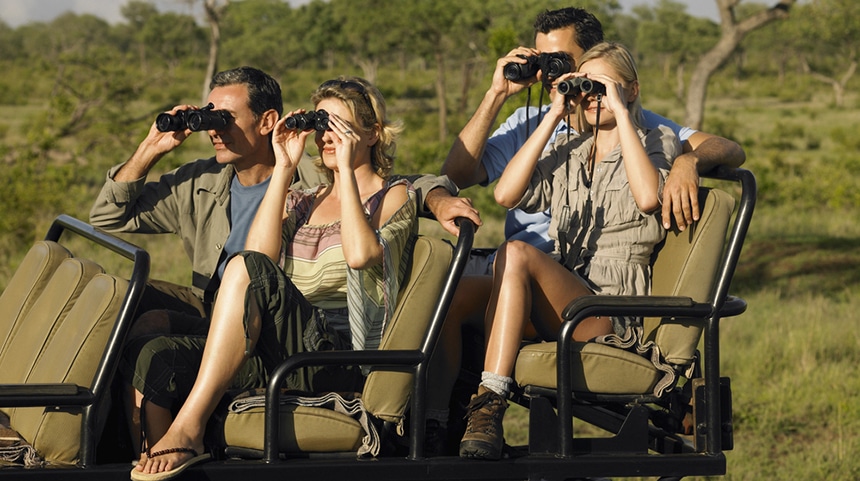
This is definitely something to think about when you are buying your binoculars. Obviously, we all like to be able to spend a lot of money on products like this but it really depends on your own budget. Going on safari in Africa probably has set you back a fair bit of cash anyway, so it is hard to then spend a lot of money on accessories. A lot of people want to go all out for safari and buy things like cameras, new lenses and binoculars.
One great thing about the best binoculars is the fact that they can last a very long time. Often, they come with lifetime warranties, or at least very long warranties, so you don’t have to worry about whether they are going to last for a long time, rather whether you can afford them in the first place.
There are budget binoculars for safari that you can buy for under $100, and some of these can do a pretty good job. If you are on a budget then they are certainly a better option than not taking binoculars and risking missing out on some of the amazing sights. If you are really serious about it, though, you will probably want to spend a little more. For a mid-range set of binoculars that has a lot of likeable features, the Celestron Granite 7×33 is one of the best choices.
Some binoculars include other features to try and stand out from the competition, but one of the main ways in which manufacturers make their products look better is to include a lot of accessories. Things like lens caps, neck bands and wipes to ensure the longevity of your binocular, and that they are likely to be protected. A case is a very useful extra as it can sometimes be hard to match up binoculars to a case that is the exact right size, so it is important to think about this before making the purchase. A case gives so much protection.
Firstly, you need to make sure you remove any dust from the binocular’s lenses. Loose dust will shake clean.
Next, moisten a q-tip just with water, or use a little bit of specific glasses cleaning solution, which lets you pick off any other bits of dust that are sitting on the lens. Finally, you can use the lens wipes to polish and do the final cleanup of your binoculars.
On top of cleaning, there is a lot to think about with your binoculars, and keeping them in a case is essential to make sure they are kept safe from the elements and cannot be damaged when you least expect it. If you are going on safari, they are probably coming on a plane with you, so this is even more essential.
Coming in at the very top of our list of the best binoculars for Safari is the Celestron Nature DX 8×32, these aren’t too expensive and they do a very good job over long distances, with a more-than-respectable field of view rating. We’ve given these 9.9/10, and their quality is helped by the fact that they also have a limited lifetime warranty to protect your purchase.
Next is the Bushnell Legend L-Series 10×42 which boasts a magnesium chassis meaning great quality and even though they have a lightweight design they are very rugged and durable, so built to last a long time. On top of this, they have a brilliant lens coating. We’ve given them 9.8/10.
The budget pick is the Nikon Trailblazer 10×25 ATB, which gives a brilliant look and feel and give a fantastic image reproduction, in spite of the fact that they don’t cost a huge amount of money. You can enjoy all the benefits of optics made by Nikon without it costing too much money.
